This I know: My sister is the best gift giver in the world. At least when it comes to the most important gifts of all–those being, of course, ones given to me.
I received the latest evidence of this eternal verity on Christmas, when I opened a package which turned out to contain a French comic album. One published in 1938. Which, she later told me, she bought at a flea market in Bordeaux.
Here’s its cover:
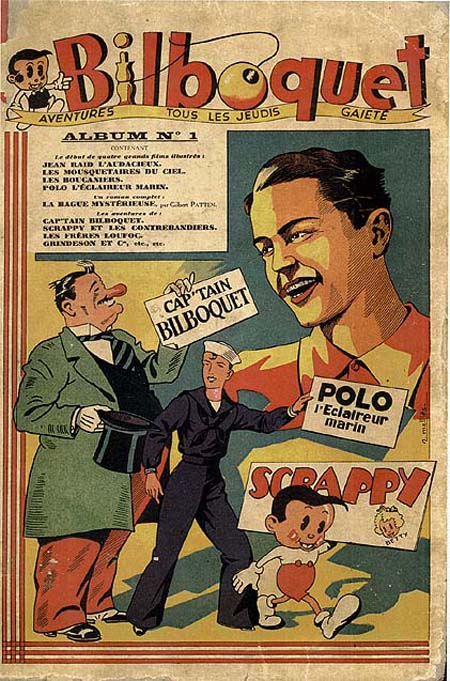
Hmmm, that’s interesting–there’s Major Hoople, and his name in France was Captain Bilboqu–HEY! THAT’S SCRAPPY!
Bilboquet, about which I know nothing other than what I can divine from this album (which compiles the first 25 weekly issues) consisted mostly or entirely of American comics (and other features from the U.S., such as Frank Merriwell text stories). Its name means “ball and cup,” and yes, its mascot was Scrappy, as evidenced by the fact that he appeared as part of its logo.
Inside, Scrappy starred in an adventure story–“Scrappy Et Les Contrebandiers”–that was serialized one page at a time. I haven’t yet tried to apply my rusty French to translating it in full. But I can tell that it’s set on the Rio Grande, and that it stars his Scrappiness, Margy (called Betty in France), Yippy, a Monopoly Man-like tycoon, an evil Mexican guy, and a Phantom Blot-like mystery villain.
Here are a few representative pages:
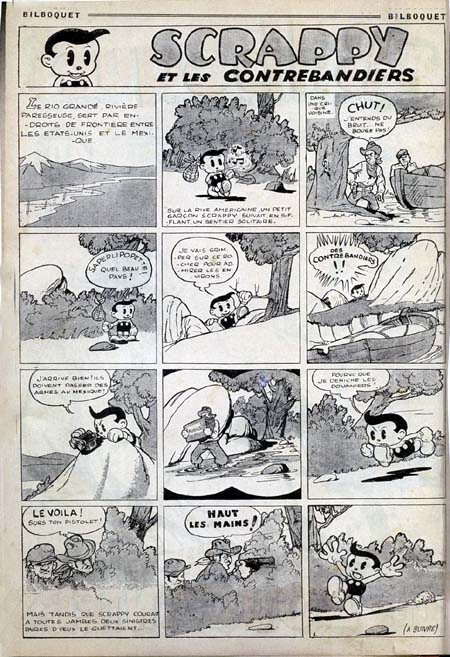
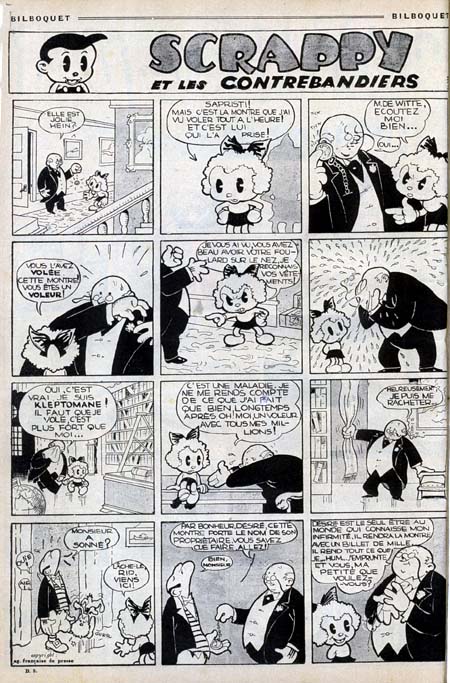
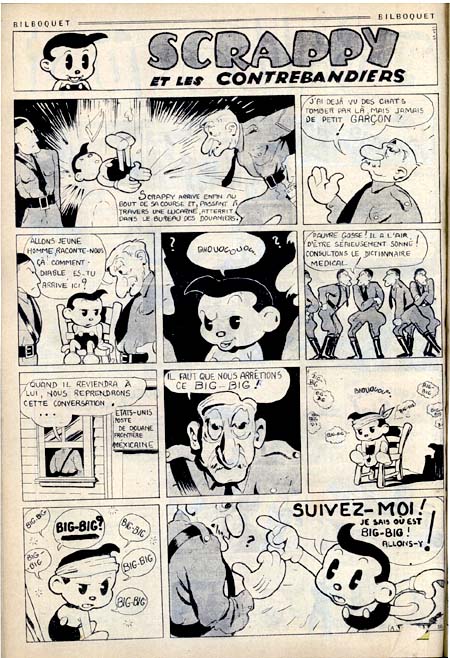
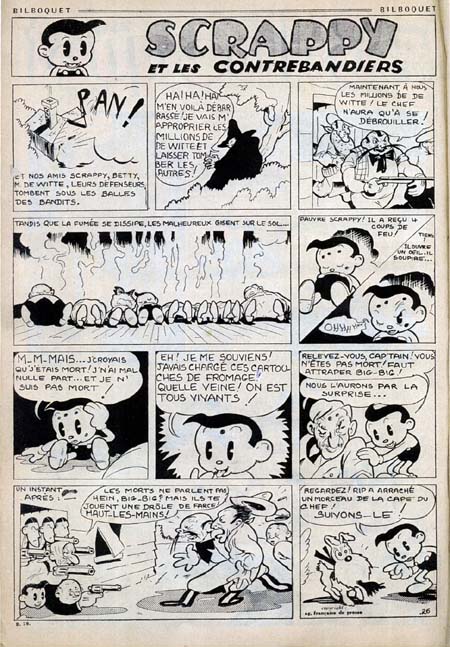
When I looked at these, the first thought that popped into my mind? Plucky kid with an improbable cowlick. Fuzzy little dog. Serialized crime-busting adventures. Could it be that Scrappy was Bilboquet‘s weird, imported answer to Tintin?
These are, I think it’s fair to say, incredibly rare comics. But not so rare that I didn’t blog about them last year, when I hadn’t seen them and didn’t know if they’d ever actually been published anywhere. In that post, I explained that in 1937, the tiny comics syndicate run by Jerry Iger and a very young Will Eisner had advertised a Scrappy strip as being available. These French Scrappy comics are pretty clearly the Iger-Eisner ones, since Bilboquet also features Hawks of the Seas, Eisner’s primitive-but-promising pirate saga.
So Will Eisner apparenly had a hand–at least businesswise–in these Scrappy comics. That leads to one inevitable question: Are they his work? Jerry Bails’ Who Who of American Comic Books does credit Eisner with having written, drawn, and inked Scrappy comics. But that brief reference is the only thing I’ve been able to find associating the great cartoonist with Scrappy–more extensive discussions of Eisner’s early work, such as this excellent piece, make no mention of the strip. (I checked in with the article’s author, Ken Quattro; he doesn’t have any information on an Eisner-Scrappy connection.)
(Bilboquet, by the way, runs the strips with a French copyright, no credits, and no mention of Scrappy’s American, animated origins; I don’t know if anyone in France even knew that he appeared in movie cartoons.)
Will Eisner was, of course, one of the most distinctive cartoonists of all time; in theory, you might be able to identify Scrappy as his work, or reject it as being such, simply by eyeballing it. But in the 1930s, his style was still a work in progress, and I’ve never seen any true bigfoot cartooning by the man. The best conclusion I can come to by examining the art is that while I can’t rule out the possibility that it’s his, there’s no obvious Eisneresque element to any of it, with the exception of the fact that one character (seen above) looks a bit like a more cartoony Inspector Dolan.
Actually, there’s one other exception, and it’s signficant. Dig the atmospheric first panel in this sequence, which looks like it could have come from a 1940s Spirit story:

That’s the only panel in all of Bilboquet‘s Scrappy material that does look like Eisner, and perhaps that’s evidence that the rest of the material isn’t his. Although, looking at it, I see that the style wavers a lot from strip to strip–I wouldn’t be surprised if more than one member of the Iger-Eisner shop had a hand in it. (Actually, now that I look at the pages above, it looks like the first one, at least, might be the work of an entirely different cartoonist than whoever did the later ones.)
Incidentally, it doesn’t look much like the work of two Iger-Eisner cartoonists who did have a background in cartoony comics–Jerry Iger himself and the pre-Batman Bob Kane. But I can’t rule out the possibility that the strip was done by someone who worked on Scrappy cartoons. (To my eye, though, it looks like it was done by a newspaper cartoonist, with the aid of old Scrappy model sheets–by 1937/38, the animated Scrappy had been modernized and cutened up somewhat.)
Another possibility: Could at least some of this work have been done specifically for the French market, either in the U.S. or in France? (Note that the first strip above looks like it might consist of daily strips pasted up into a one-page chapter, while the later pages are a bit more free-form in structure.)
I hope it goes without saying that I’d love to hear any information you might have on these comics–be it solid evidence or informed speculation.
But wait, there’s more…
The day after Christmas, I got an e-mail from comics scholar D.D. Degg. He pointed me towards an online archive of 1937 issues of a newspaper called the Grosse Pointe Review which featured a different Scrappy comic strip, Scrappy Sayings. (It apparently appeared in some papers as early as 1935.) Yup–in 24 hours, I’d gone from never having seen any Scrappy newspaper comics to having seen two different Scrappy features.
Scrappy Sayings is nowhere near as tantalizing as the French stuff. But being Scrappy-related, it’s decidedly odd–kinda like a 1930s version of Love Is, except with bad puns and (thank God) clothing.
Here’s a sample:
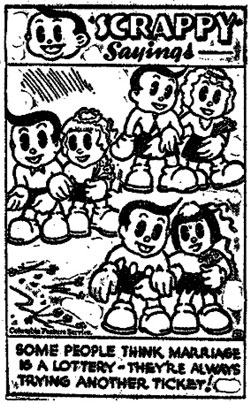
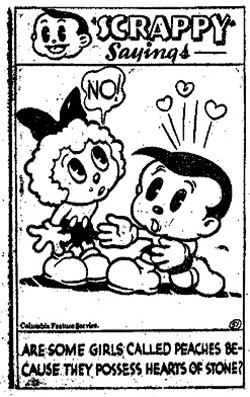
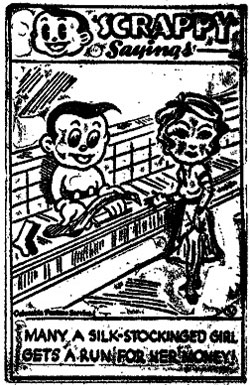
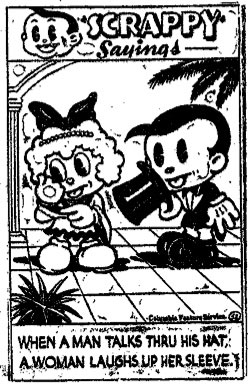
As far as I know, I’ve now seen examples of all the Scrappy newspaper comics that were ever done. I’m probably wrong, though–with Scrappy, the only safe assumption is that there are no safe assumptions…
